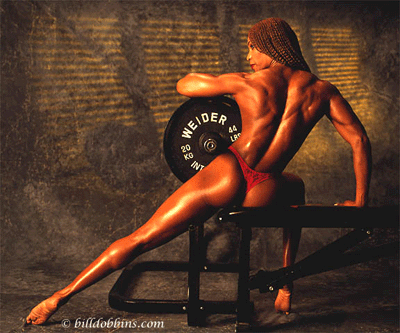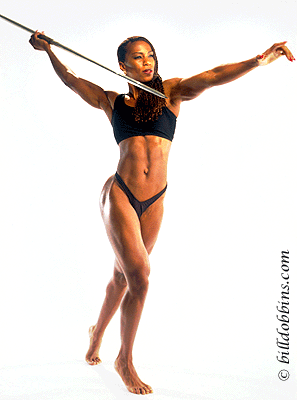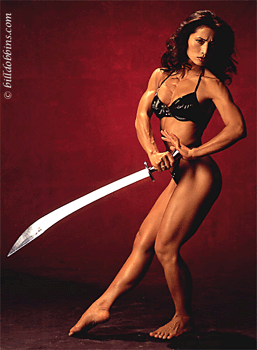WOMEN ATHLETES AND WEIGHT TRAINING
"Weight training is the single
biggest factor
in improving the performance of elite female
athletes."
By Bill Dobbins

Once upon a time, it was considered
unfashionable for women to develop well-defined muscles. Of course, once
upon a time women wore bustles and were considered too delicate to function
in the world of politics, business, medicine, the law and other fields thought
to be the sole territory of the male. You couldn't even say the word "legs"
in front of a lady. "Limbs" was the preferred terminology.
Unfortunately, while most of these Victorian limitations and restrictions on the female gender went out of vogue some time ago, it is only recently that the once virtually universal rejection by society of the idea of women developing muscles has turned to (at least, partial) acceptance.Remarkably, despite the enormous development in the sport of bodybuilding for women during the past 12 or 14 years, female physique competitors with their incredibly muscular bodies are not the primary cause of this revolution in thinking about physical potential of the female.According to Tony Duffy, founder of Allsport, the world's largest international sports photo agency, the greatest impact has come from female track and field athletes like the late Florence Griffith Joyner and Jackie Joyner-Kersee.
"When I first began photographing sports for a living back in the late 1960's," explains Tony Duffy, "nobody was interested in women's sports. It got no publicity at all. Women's athletics was considered something of a joke and women athletes as a bit suspect. The public perception of women athletes was bloody awful." The women athletes themselves were apparently all too aware of how they were regarded by the public. "In those days," Duffy goes on, "I would be constantly cautioned by the women not to make them look too muscular in photos. There was a social stigma attached to muscular women, and in spite of how motivated they were to excel in their sports, they weren't willing to subject themselves to criticism by over-developing their bodies."
So as hard as women might have trained back then, any kind of strength training,
working out with weights, "pumping iron," was usually totally
out of the question. Unfortunately, this reluctance to build and strengthen
their muscles was reflected in the levels of their athletic performance.
The achievements of women in sports in those days, particularly in track
and field, was a far cry from what we see today.
as hard as women might have trained back then, any kind of strength training,
working out with weights, "pumping iron," was usually totally
out of the question. Unfortunately, this reluctance to build and strengthen
their muscles was reflected in the levels of their athletic performance.
The achievements of women in sports in those days, particularly in track
and field, was a far cry from what we see today.
Steve Wennerstrom, editor-in-chief of
Women's Physique magazine and official historian of the IFBB for women's
bodybuilding, was a woman's track coach beginning in the early 1970s,
and he experienced this resistance to the idea of strength training for
women first hand.
"I ran track myself," says Wennerstrom, "and when a shot-putter
and discus thrower friend of mine put me on a strength program, my times
increased dramatically. So I was confident that the women I was training
would experience the same kind of benefits if they undertook a proper
program of muscle development. And it worked. I found that weight training
was the single biggest factor in improving performance in experienced,
elite athletes." "A number of the women I coached were willing
to accept the idea of strength training at first," he goes on, "but
got nervous after a week or two in the gym when they began to feel sore
in ways they weren't used to. I also had ongoing feuds with other coaches
who were dead-set against the idea. Some of them approved of strength-training,
but were very football-oriented and when women on the UCLA team like Florence
and Jackie came into the gym and started doing bodybuilding-style workouts
they were very much opposed to this. They believed in something more specific,
but these women had never lifted before and needed overall development
rather than sports-specific training."
The biggest obstacle in those days, Wennerstrom says, was where to get the right kind of training information. "I looked through magazines like Joe Weider's MUSCLE BUILDER and went to bodybuilding contests whenever I could, but there were no women competing back then. But even the meager information I was able to get really helped the women I was coaching. They were stronger, faster and much less prone to injury. However, by the end of the 1970s promoters began to stage contests for women, you had stars emerging like Lisa Lyon, and the whole idea of strength-training for women in sports was suddenly a lot easier idea to get accepted."
Lynn Conkwright, former Women's World Bodybuilding Champion, was a gymnast and a gymnastics coach before becoming a physique competitor, and she was a believer in weight training long before it became at all acceptable, much less fashionable. Actually, she explains, it was the fact that she was already doing a 4-day split system routine well before women's physique events even existed that allowed her to step into bodybuilding and ascend to the top so quickly. "Every female athlete I've coached who has done weight training properly has benefited by it," says Lynn. "And not just gymnasts, either. In fact, after I competed in an ABC Television "Superstars" event, I was asked by Martina Navratilova to put her on a basically free-weight, bodybuilding-type program. And I subsequently worked with several other tennis players and weight training helped them out a lot as well."
By the early 1980s, women athletes in
track and field had also pretty much  accepted
the idea of---at least some---intense weight training as part of their
overall training program. Sha-ri Pendleton, who appears as "Blaze"
on the American Gladiators television program and who is a former all-around
track athlete, recalls what a difference it made going from a high school
with no weight program to speak of to a University with a first-rate program
of strength-training for both male and female athletes. "When I was
in high school in Los Angeles," Sha-ri explains, "we had a coach
that encouraged the women to use the weight room, but I was the only one
who really took it seriously. However, at the time, I was competing in
the 100 meter hurdles, the 4X4 relay, the long jump, as well as running
the 100 and 200 meter dash and the 400 as well. So when I started working
with heavier weights the coach was against it. She wanted me to do lighter,
high-rep, pumping-type workouts. But I figured I got enough endurance
activity out on the track. I was fairly skinny at the time, and what I
wanted was more muscle. And the more I got, the more I wanted, especially
since the stronger I got the more my performance improved."
accepted
the idea of---at least some---intense weight training as part of their
overall training program. Sha-ri Pendleton, who appears as "Blaze"
on the American Gladiators television program and who is a former all-around
track athlete, recalls what a difference it made going from a high school
with no weight program to speak of to a University with a first-rate program
of strength-training for both male and female athletes. "When I was
in high school in Los Angeles," Sha-ri explains, "we had a coach
that encouraged the women to use the weight room, but I was the only one
who really took it seriously. However, at the time, I was competing in
the 100 meter hurdles, the 4X4 relay, the long jump, as well as running
the 100 and 200 meter dash and the 400 as well. So when I started working
with heavier weights the coach was against it. She wanted me to do lighter,
high-rep, pumping-type workouts. But I figured I got enough endurance
activity out on the track. I was fairly skinny at the time, and what I
wanted was more muscle. And the more I got, the more I wanted, especially
since the stronger I got the more my performance improved."
The University of Nebraska had a good strength training program in the early 1980s, and Sha-ri went on to become an NCAA triple-jump finalist. She also won events at 400 meters and 100 meter hurdle and she set her sights on competing in this event in the Olympics. "But even at Nebraska," Sha-ri recalls, "as good as their program was, a lot of the women athletes were still reluctant to do really serious strength-training. They were afraid they'd get too bulky, lose range of motion, get too tight to run. They'd come to me and criticize my workouts, but I'd end up beating them in track meets. It never seemed to occur to them there was a cause and effect relationship between my workouts and performance in competition."
Certainly, getting "too bulky" could be a problem for any athlete who follows an improperly designed workout program. Weight training, particularly the type developed by competition bodybuilders over the years, can add a lot of muscle mass to your physique. This could lead---theoretically---to an athlete getting too heavy, losing his or her ideal strength-to-weight ratio, to changes in overall body conformation unsuited to a particular sport. But in a well-designed program, this rarely happens.
"When you are involved in training for track events," says Ms. Olympia Cory Everson, who was a successful pentathlete before dominating women's professional bodybuilding through the mid and late 1980s, "you spend a lot of time training. You burn up incredibly amounts of energy. That makes adding any significant amount of bulk to your physique very difficult. Bodybuilders train intensely for relatively short periods and then rest. This gives them a lot of energy to be used in building and rebuilding muscle tissue. But track athletes burn up this excess energy in training, so getting too big isn't usually the problem---it's the opposite: getting big and strong enough and keeping that size and strength through a demanding track season."
"You obviously shouldn't do weight
training to the point where you develop too much mass for a specific sport,"
says Steve Wennerstrom. "Your overall body size and confirmation
should be the result of the time you spend training for a specific sport.
But if you can increase your lean body mass, decrease your relative body
fat, you can produce a much fitter, stronger and more efficient physique,
which will make you that much better a competitor." Obviously, women's
athletics has changed a great deal in the past decade or so. The appearance
of Olga Korbut in the 1972 Olympics revolutionized gymnastics for girls
in this country and around the world. After Billie Jean King paved the
way, women tennis players from Chris Everet to Stefi Graff have turned
tennis into a big-money sport. Golf for women has also experienced an
explosive growth in both popularity and prize money.
The same thing, of course, has happened in sports like women's track and
field. And it is this increased recognition and especially the money that
can be earned by the elite performers that has helped weight training
to gain such widespread acceptance among today's women athletes.
"Track is a full time occupation out of which you can make a good living if you do it right," says Tony Duffy. "As a result, track athletes are approaching training with a lot more professionalism. This kind of sport used to be the province of the dilettante. For people who were naturally athletic and wanted to compete against other athletes to see who was the best. Nowadays, with so much money in the sport, they are less inclined to worry about things like becoming too muscular for popular fashion and are more concerned with performance. So if weight training makes them more muscular, as long as it helps them to win, that's all that matters."
"Also, the success of women like Florence Griffith Joyner has also done a lot to make muscular women more fashionable. She managed to combine muscularity with femininity because she had a lean, well-proportioned body and when you add muscle to it that only makes it look better. Not only did Flo-Jo win gold medals, but the other athletes saw her on the cover of Sports Illustrated and Life, as well. This did a lot to make a more muscular looking body more acceptable." "Another incredible woman athlete is Jackie Joyner-Kersee," adds Duffy. "She hasn't got the most muscular physique, but she's the best all-around woman in the sport, and she does a lot of weight training to enhance her performance. She was very strong, had incredible coordination, and was virtually unbeatable for 10 years or so.
One of the reasons women are benefiting
so much from weight training, Steve Wennerstrom believes, is that they're
getting away from old-fashioned ideas of strength-training and moving
more in the direction of a program based on the kind of training practiced
by world-class bodybuilders.
"An athletes, male or female," he says, "should begin by
doing non-specific type training, a program designed to build and strength
the entire body using mostly free weights, combining 2-joint barbell lifts
with isolation, 1-joint movements, working each and every muscle with
the proper balance and proportion and only then consider doing exercises
that may be designed to be sports-specific."
Unbalanced training, he adds, which is what most traditional strength-training
programs usually are, increases strength imbalances in muscles in relation
to each other than are probably already disproportionately developed because
of sports-specific training. Bodybuilding restores this balance, which
not only leads to better performance, but lowers the risk of injury as
well.
"The whole idea," concludes Tony Duffy, "is to produce a body that performs better. However, as bodybuilders have proved, when you train a physique properly it also starts to look better. And I think that's an important aspect of sports today, particularly for women." "As the human race becomes more civilized," he believes, "and more sedentary, as we begin to depend more on computers to do things for us, as we come less and less physical, the elite athlete, who is the total opposite, becomes more and more in demand aesthetically. There is an aesthetic joy in watching these very outstanding, physical specimens.
As far as different types of bodies are concerned, bodybuilders are like living statues, works of art. Track and field athletes are more like the thoroughbreds of sport. Watching them perform, seeing them compete, is as exciting as watching a thoroughbred race horse or seeing an animal like a greyhound or cheetah at full speed. Awesome and impressive---but very beautiful as well."
.